Akseli Gallen-Kallela
Akseli Gallen-Kallela | |
|---|---|
 | |
| Born | Axel Waldemar Gallén 26 April 1865 |
| Died | 7 March 1931(aged 65) |
| Nationality | Finnish |
| Known for | Painting |
| Movement | Romantic nationalism,Realism,Symbolism |
Akseli Gallen-Kallela(26 April 1865 – 7 March 1931) was aFinnishpainterwho is best known for his illustrations of theKalevala,the Finnish nationalepic.His work is considered a very important aspect of the Finnish national identity. Hechanged his namefrom Gallén to Gallen-Kallela in 1907.[1]
Life and career[edit]
Early life[edit]
Gallen-Kallela was bornAxel Waldemar GalléninPori,Finland, in aSwedish-speakingfamily. His father Peter Gallén worked as police chief and lawyer.[2]Gallen-Kallela was raised inTyrvää.[3]At the age of 11 he was sent toHelsinkito study at a grammar school, because his father opposed his ambition to become a painter. After his father's death in 1879, Gallen-Kallela attended drawing classes at theFinnish Art Society(1881–1884) and studied privately underAdolf von Becker.[1]
Paris[edit]

In 1884 he moved toParis,to study at theAcadémie Julian.[4]In Paris he became friends with the Finnish painterAlbert Edelfelt,the Norwegian painterCarl Dørnberger,and the Swedish writerAugust Strindberg.[1]During this period he traveled back and forth between Finland and Paris.[1]
Mary Slöör[edit]


He marriedMary Slöörin 1890. The couple had three children, Impi Marjatta,KirstiandJorma.On their honeymoon toEast Karelia,Gallen-Kallela started collecting material for his depictions of theKalevala.This period is characterized byromanticpaintings of theKalevala,such as theAino Myth,and by several landscape paintings, although by 1894 the influence ofsymbolismis heavily visible in his works.[1]
-
Madonna (Mary and Marjatta),1891(fi)
-
Shepherd Boy fromPaanajärvi,1892
-
Portrait of the Artist's Wife,1893
-
Conceptio Artis,1894
-
Ad Astra,1894(fi)
Berlin and tragedy[edit]

In December 1894, Gallen-Kallela moved toBerlinto oversee the joint exhibition of his works with the works ofNorwegianpainterEdvard Munch.At the time Gallen-Kallela also designed a grand cabin calledKalelafor his family far from everything on the shore ofLake Ruovesi.It was built from dead standing pine by 13 local carpenters in a year from 1894 to 1895.[12][13]
In March 1895, his trip was ended when he received a telegram that his daughter Impi Marjatta had died fromdiphtheria.This would prove to be a turning point in his work. While his works had previously been romantic, after his daughter's death Gallen-Kallela painted more aggressive works. In the years 1896–1899 he painted what are considered his most famous works:The Defense of the Sampo,Lemminkäinen's Mother,Joukahainen's RevengeandKullervo's Curse.[1]In May 1895, Gallen and Mary visitedLondon,with his intent being the purchase of agraphic artpress. While there he also learned aboutstained glass.At the end of 1897 the family took a trip toFlorence,also visitingPompeii,where he studied the art offrescoes.[1]
-
Portrait of Edvard Munch,1895
-
Kalela on a Winter Night,1896
-
The Artist's Mother,1896
-
The Defense of the Sampo,1896(fi)
-
Joukahainen's Revenge,1897(fi)
-
The Fratricide,1897, fromKanteletar
-
Mary Sewing on the Veranda of Kalela,1897
-
Kullervo's Curse,1899(fi)
-
February Vision,1899
Paris 1900 Exposition[edit]
For theParis World Fairin 1900, Gallen-Kallela paintedfrescoesfor the Finnish Pavilion.[1]In the frescoIlmarinen Plowing the Field of Vipersthere was a hidden political message: one of the vipers is wearing a smallRomanovcrown,[14]telling of Gallen-Kallela's wish for an independent Finland at the time of theRussification of Finland.
The Paris Exposition secured Gallen-Kallela's stature as the leading Finnish artist.[15]In 1901 he was commissioned to paint the fresco,Kullervo Sets Off for War,for the concert hall of the Helsinki Student's Union.[15]Between 1901 and 1903 he painted the frescoes for theJusélius MausoleuminPori,memorializing the 11-year-old daughter of the industrialistFritz Arthur Jusélius.(The frescoes however were soon damaged by dampness, and were completely destroyed by fire in December 1931. Jusélius assigned the artist's son Jorma to repaint them from the original sketches.[16]The reconstruction was completed just before Jorma's death in 1939.)[1]
Gallen-Kallela officiallyfinnicizedhis name to the more Finnish-sounding Akseli Gallen-Kallela in 1907.[1]His idea for a 700-pageGreat Kalevalawas fully formed in 1909 with a publication of his plan in theValvojamagazine.[17]
-
Sketch for the 1900 Exposition frescoIlmarinen Plowing the Field of Vipers,1899
-
Liekkiryijy,designed by Gallen-Kallela
-
Spring,c. 1900
[note 4] -
Kullervo Sets Off for War,1901, large mural atOld Student House
-
The Theft of the Sampo,1905(fi)
-
The Departure ofVäinämöinen,1906(fi)
-
The Lair of theLynx,1906
-
Bil-Bol, Poster for an Automobile Retailer,1907
Kenya[edit]


In 1908 with renewal in mind, Gallen-Kallela and his family moved to Paris. However the city and the new direction art was being taken didn't feel as hospitable as he had hoped, and so in May 1909 they moved much further away toNairobiinKenya.He was the first Finnish artist to paint south of theSahara,and he totalled over 150expressionisticworks. Although artistically the paintings are of fluctuating quality, their colors and the synergy of the colors are remarkable. They returned to Finland in February 1911.[1]Between 1911 and 1913 he designed and built a studio and house for his family atTarvaspää,approximately 10 km northwest of the centre of Helsinki.[19]
-
The Oceanides,1909
-
Café in Paris,1909
-
Skeleton of a Camel,1909
-
Untitled, 1909
-
KikuyuWoman,1909
-
Portrait of Kenosua,1909–1910
[note 5] -
Rhinoceros and Euphorbia Trees,1909–1910
-
Hippos in theTana River,1910
-
Homo Victor(Victorious Man), 1910
-
Coral Tree in Blossom,1910
Finnish Civil War[edit]


The family moved back from Tarvaspää to Kalela in 1915 to escape the turmoil ofWW I.A few years later in 1918, Gallen-Kallela and his son Jorma took part in the fighting at the front of theFinnish Civil War.When the regent,General Mannerheim,heard about this, he invited Gallen-Kallela to design the flags, official decorations and uniforms for the newly independent Finland. For theflag,Gallen-Kallela proposed a white-blue cross flag, with colors inverted (white cross on blue), but this was considered too similar to the Swedish flag and particularly the Greek flag of the time. In 1919 he was appointedaide-de-campto Mannerheim.[1]In 1920 he made an agreement with the publishing companyWSOYfor the eventual publication ofGreat Kalevala,with the less decorativeKoru-Kalevalabeing published first in 1922.[17]
-
Kalela in Autumn,1915
-
The Lovers,1906–1917
-
Portrait of Mary,1917
-
Kirsti Playing the Cello,1917
-
Regretful Kullervo,1918
-
Lemminkäinenby the River of Fire,1920
Taos, New Mexico, and later life[edit]

In December 1923 he moved to the United States, where his family also followed him in autumn 1924. He first spent time inChicago,and an exhibition of his work toured several cities.[21]In Chicago he was impressed by Native American art and moved toTaos, New Mexico,at theart colonythere to study it further. During this time in the United States he also began sketching out theGreat Kalevalain much more detail. In May 1926, the family returned to Finland. Two years later in 1928 together with his son Jorma he painted theKalevalafrescoes at the lobby of theNational Museum of Finland.Then in 1930 he made an agreement to paint a gigantic fresco for the bankKansallis-Osake-Pankki,but on 7 March 1931 while returning from a lecture inCopenhagenhe suddenly died ofpneumoniainStockholm.[1]
-
Indian Chief Clear Water,1924
-
The Indian Sia Ohutaa,1925
-
Our Home in Taos,1925
-
Taos Home in Sunlight,1925
-
Indian on Horseback in Snow,1925
-
Taos,1925
-
Crack Willow and Blue Bird in New Mexico,1925
-
The Great Pike,1928 fresco based on an earlier a 1904 painting
-
Portrait of Carl Gustaf Emil Mannerheim,1929
-
Page depicting the birth of Väinämöinen from the unfinishedGreat Kalevala,1920–1930
Legacy[edit]
His studio and house at Tarvaspää was opened as theGallen-Kallela Museumin 1961; it houses some of his works and research facilities on Gallen-Kallela himself.[22][23]
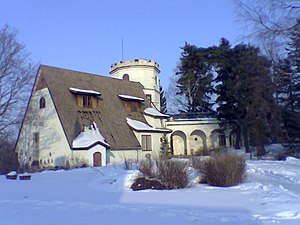
See also[edit]
Notes[edit]
- ^The girl who modeled for the painting was a futureparliamentmember,Maria Raunio.[5]
- ^The frames were painted byElin Danielson-Gambogi.[7]
- ^Gallen-Kallela was inspired by Sibelius' tone poem En saga (A Fairy Tale). On the right is Sibelius himself, at top left is the visuals it brought to Gallen-Kallela's mind and the empty section at bottom left was supposed to have notes from the tone poem, but Sibelius didn't wish to add them.[10][11]
- ^There is also a Jusélius Mausoleum fresco called Spring from 1903.
- ^He was an aide and a friend to the Gallen-Kallela family and always escorted the family's children to school.[20]
References[edit]
Citations[edit]
- ^abcdefghijklmReitala 1997.
- ^Martin & Pusa 1985,p. 5.
- ^Musée d'Orsay 2012.
- ^Martin & Pusa 1985,p. 65.
- ^Pohjolainen 2016.
- ^Hämäläinen 2018.
- ^Okkonen 1916,pp. 248–261.
- ^Sipilä 2019.
- ^Leppänen 2020.
- ^Ainola.
- ^von Donsdorff 2017.
- ^Ruovesi.
- ^Yle 2010.
- ^Saressalo 2018.
- ^abMartin & Pusa 1985,p. 12.
- ^Martin & Pusa 1985,p. 37.
- ^abMikkonen 2017.
- ^Aksa 2018.
- ^Martin & Pusa 1985,p. 38.
- ^Kulttuurikurkkaus 2019.
- ^Martin & Pusa 1985,p. 39.
- ^Gallen-Kallela Museum 2015.
- ^Ringbom 1996.
Sources[edit]
Books[edit]
- Jackson, D.; Wageman, P., eds. (2006).Akseli Gallen-Kallela, De magie van Finland[Akseli Gallen-Kallela, The Magic of Finland] (softcover) (in Dutch). Rotterdam: NAi Booksellers /Groninger Museum.ISBN978-90-5662-523-8.
- Martin, Timo; Pusa, Erja (1985).Akseli Gallen-Kallela, 1865-1931(hardcover). Translated by John Derome. Tarvaspää:Gallen-Kallela Museum.OCLC29071282.
- Okkonen, Onni (1916). "Trip to Kuusamo".Akseli Gallen-Kallela, elämä ja taide[Akseli Gallen-Kallela, life and art] (in Finnish). Porvoo-Helsinki:Werner Söderström Osakeyhtiö(WSOY).
- Pohjolainen, Raija (2016).Tyttö Keuruun vanhassa kirkossa[A girl in the old church in Keuruu] (in Finnish). Vantaa: Kellastupa.ISBN978-95-2578-723-8.
Websites[edit]
- "Ainolan taideteokset / Aino ja Jean Sibeliuksen koti"[Welcome to Ainola! / The home of Aino and Jean Sibelius].Ainola(in Finnish).Retrieved22 August2020.
- "Akseli Gallen-Kallela (1865-1931). A Passion for Finland".Musée d'Orsay. 2012. Archived fromthe originalon 8 March 2021.Retrieved30 November2018.
- "Akseli Gallen-Kallela ikuistiKeitelettä– teoskopio sai paikan Lintulahden Nesteeltä "[Akseli Gallen-Kallela immortalizedKeitele- a copy of the work was received from Lintulahti Neste].Aksa(in Finnish). 9 December 2018.Retrieved21 August2020.
- "Gallen-Kallela 150 years".Gallen-Kallela Museum.2015.Retrieved4 January2017.
- "Gallen-Kallelan rapistunut erämaa-ateljee avataan heinäkuuksi"[The dilapidated wilderness studio in Gallen-Kallela will open in July].Yle(in Finnish). 29 June 2010.Retrieved21 August2020.
- Hämäläinen, Jukka (24 May 2018)."Suomen Pankki esittelee taideaarteitaan avoimin ovin – Tiesitkö että Aino-triptyykistä on kaksi erilaista versiota?"[The Bank of Finland presents its art treasures openly - Did you know that there are two different versions of theAinotriptych?].Vantaan Sanomat(in Finnish).Retrieved21 August2020.
- "Kalela".Ruovesi.Retrieved21 August2020.
- "Kulttuurikurkkaus"[Cultural corner](PDF).Gallen-Kallela Museum(in Finnish). August 2019.Retrieved22 August2020.
- Leppänen, Mikko (23 January 2020)."Gallen-KallelanPalokärkipäätyi pariisilaiseen taidemuseoon "[Gallen-Kallela'sPalokärkiended up in an art museum in Paris].Yle(in Finnish).Retrieved21 August2020.
- Mikkonen, Nadja (19 September 2017)."Suur-Kalevala oli Akseli Gallen-Kallelan hurja haave – haukkui kirjeellä kustantajan, kun ymmärrystä ei löytynyt"[TheGreat Kalevalawas Akseli Gallen-Kallela's wild dream - the publisher barked with a letter when no understanding was found].Yle(in Finnish).Retrieved25 August2020.
- Reitala, Aimo (16 September 1997)."Gallen-Kallela, Akseli (1865–1931)".100 Faces from Finland – a Biographical Kaleidoscope.Translated by Fletcher Roderick. Biographical Centre of the Finnish Literature Society.Retrieved4 February2017.
- Ringbom, Sixten(1996)."Gallen-Kallela, Akseli (1865–1931), painter, graphic artist, designer".Grove Art Online.Oxford Index.Retrieved4 February2017.
- Saressalo, Lassi (2018)."Matka kultakauteen Kansallisromantiikkaa Kainuusta ja kauempaakin"[A journey into the golden age National romance from Kainuu and beyond].Kotiseutuliitto(in Finnish).Retrieved20 August2020.
- Sipilä, Annamari (4 November 2019)."Mysteeriomistajalla vuosikymmeniä ollut Gallen-Kallelan miljoonateos Palokärki tulee myyntiin New Yorkissa – lintuun kiteytyy suomalaisten vastarinta"[Gallen-Kallela's millennial workPalokärki,which has had a mystery owner for decades, goes on sale in New York - Finnish bird crystallizes resistance].Helsingin Sanomat(in Finnish).Retrieved21 August2020.
- von Donsdorff, Anna-Maria (2017)."Correspondences – Jean Sibelius in a Forest of Image and Myth"(PDF).FNG Research.Retrieved22 August2020.
External links[edit]
![]() Media related toAkseli Gallen-Kallelaat Wikimedia Commons
Media related toAkseli Gallen-Kallelaat Wikimedia Commons
- 1865 births
- 1931 deaths
- Burials at Hietaniemi Cemetery
- People from Pori
- People from Turku and Pori Province (Grand Duchy of Finland)
- Swedish-speaking Finns
- People of the Finnish Civil War (White side)
- Recipients of the Legion of Honour
- Fresco painters
- Finnish heraldists
- Heraldists from the Russian Empire
- Académie Julian alumni
- 20th-century Finnish painters
- Finnish expatriates in Kenya
- Finnish expatriates in France
- Finnish expatriates in the United States
- Finnish male painters
- 20th-century Finnish male artists


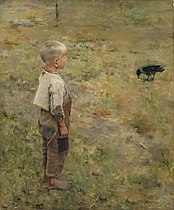



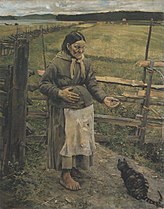
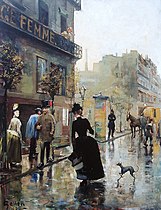







![Girl in the Old Church of Keuruu, 1889 (fi) [note 1]](https://upload.wikimedia.org/wikipedia/commons/thumb/5/5a/Akseli_Gallen-Kallela_Tytt%C3%B6_Keuruun_vanhassa_kirkossa.jpg/131px-Akseli_Gallen-Kallela_Tytt%C3%B6_Keuruun_vanhassa_kirkossa.jpg)

![Aino Myth, Triptych, 1891[6] (fi)](https://upload.wikimedia.org/wikipedia/commons/thumb/1/17/Gallen_Kallela_The_Aino_Triptych.jpg/748px-Gallen_Kallela_The_Aino_Triptych.jpg)
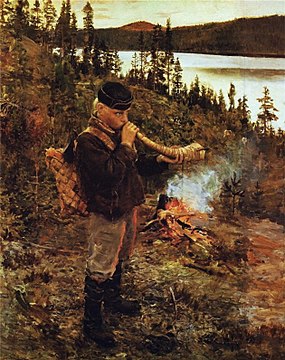
![Mäntykoski Waterfall, 1892–1894 (fi) [note 2]](https://upload.wikimedia.org/wikipedia/commons/thumb/3/3d/Akseli_Gallen-Kallela_-_M%C3%A4ntykoski_Waterfall_%28with_frames%29.jpg/222px-Akseli_Gallen-Kallela_-_M%C3%A4ntykoski_Waterfall_%28with_frames%29.jpg)


![Black Woodpecker, 1894[8][9] (fi)](https://upload.wikimedia.org/wikipedia/commons/thumb/b/bb/Palok%C3%A4rki_by_Akseli_Gallen-Kallela.jpg/221px-Palok%C3%A4rki_by_Akseli_Gallen-Kallela.jpg)

![Sibelius as the Composer of En saga, 1894 [note 3]](https://upload.wikimedia.org/wikipedia/commons/thumb/b/be/Akseli_Gallen-Kallela_-_Sibelius_as_the_Composer_of_En_saga.jpg/522px-Akseli_Gallen-Kallela_-_Sibelius_as_the_Composer_of_En_saga.jpg)







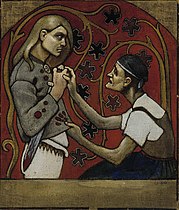
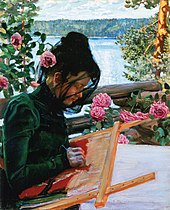
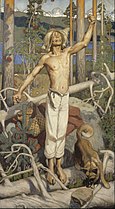



![Spring, c. 1900 [note 4]](https://upload.wikimedia.org/wikipedia/commons/thumb/f/fc/Akseli_Gall%C3%A9n-Kallela_-_Fr%C3%BChjahr_-_419_-_%C3%96sterreichische_Galerie_Belvedere.jpg/143px-Akseli_Gall%C3%A9n-Kallela_-_Fr%C3%BChjahr_-_419_-_%C3%96sterreichische_Galerie_Belvedere.jpg)


![Lake Keitele, 1905[18] (fi)](https://upload.wikimedia.org/wikipedia/commons/thumb/9/94/Akseli_Gallen-Kallela_-_Lake_Keitele%2C_1905.JPG/308px-Akseli_Gallen-Kallela_-_Lake_Keitele%2C_1905.JPG)

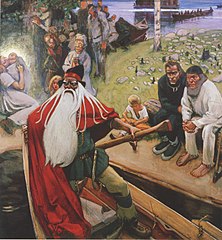
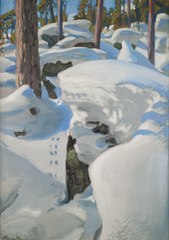

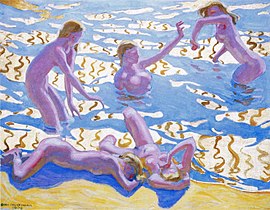

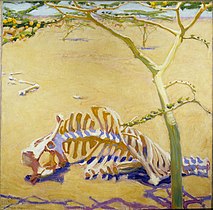


![Portrait of Kenosua, 1909–1910 [note 5]](https://upload.wikimedia.org/wikipedia/commons/thumb/2/28/Akseli_Gallen-Kallela_-_Portrait_of_Kenosua.jpg/149px-Akseli_Gallen-Kallela_-_Portrait_of_Kenosua.jpg)



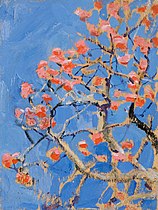








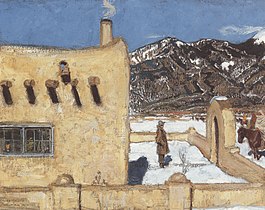



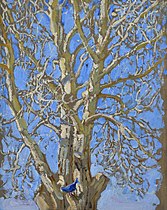

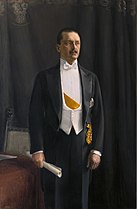
![Page depicting the birth of Väinämöinen from the unfinished Great Kalevala [fi], 1920–1930](https://upload.wikimedia.org/wikipedia/commons/thumb/b/b8/The_Great_Kalevala-_Poem_I%2C_verses_301_-_334_%28crop%29.jpg/154px-The_Great_Kalevala-_Poem_I%2C_verses_301_-_334_%28crop%29.jpg)